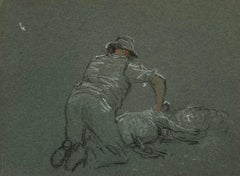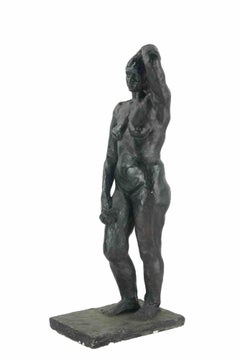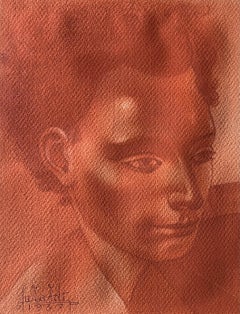Art by Medium: Chalk
Mid-19th Century Realist Art by Medium: Chalk
Chalk, Graphite
1960s Modern Art by Medium: Chalk
Chalk
Early 20th Century French School Art by Medium: Chalk
Chalk, Charcoal, Pastel, Mixed Media
2010s Modern Art by Medium: Chalk
Conté, Graphite
16th Century Old Masters Art by Medium: Chalk
Chalk, Ink, Pen, Paper
Mid-20th Century French School Art by Medium: Chalk
Pastel, Chalk
2010s Naturalistic Art by Medium: Chalk
Chalk, Conté, Ink, Mixed Media, Acrylic, Watercolor, Pencil, Carbon Penc...
1940s Expressionist Art by Medium: Chalk
Chalk, Watercolor, Laid Paper
1950s Art by Medium: Chalk
Paper, Chalk, Pencil
2010s Realist Art by Medium: Chalk
Paper, Conté, Charcoal
2010s Abstract Art by Medium: Chalk
Chalk, Pastel, Mixed Media, Acrylic, Handmade Paper
Mid-19th Century Realist Art by Medium: Chalk
Chalk, Graphite
1760s Old Masters Art by Medium: Chalk
Chalk, Laid Paper
2010s Abstract Expressionist Art by Medium: Chalk
Paint, Paper, Conté, Charcoal, India Ink, Acrylic, Tempera, Watercolor, ...
Mid-20th Century Modern Art by Medium: Chalk
Chalk, Pastel
2010s Abstract Art by Medium: Chalk
Mixed Media, Acrylic, Chalk, Pastel, Handmade Paper
Mid-19th Century English School Art by Medium: Chalk
Chalk, Handmade Paper, Pencil
1760s Old Masters Art by Medium: Chalk
Charcoal, Chalk
20th Century Art by Medium: Chalk
Paper, Chalk
18th Century French School Art by Medium: Chalk
Chalk
17th Century Dutch School Art by Medium: Chalk
Paper, Chalk
2010s Naturalistic Art by Medium: Chalk
Paper, Conté, Ink, Mixed Media, Acrylic, Pencil, Carbon Pencil
21st Century and Contemporary Contemporary Art by Medium: Chalk
Pastel, Chalk
16th Century Art by Medium: Chalk
Chalk
Mid-20th Century Outsider Art Art by Medium: Chalk
Chalk, Crayon, Watercolor, Cardboard, Pencil
Mid-20th Century Modern Art by Medium: Chalk
Chalk, Pastel
1910s Academic Art by Medium: Chalk
Paper, Chalk, Charcoal
Mid-17th Century Victorian Art by Medium: Chalk
Paper, Chalk
Mid-19th Century Realist Art by Medium: Chalk
Chalk, Graphite
Mid-19th Century Realist Art by Medium: Chalk
Chalk, Graphite
20th Century Modern Art by Medium: Chalk
Paper, Chalk
20th Century Contemporary Art by Medium: Chalk
Conté
2010s Modern Art by Medium: Chalk
Paper, Chalk
19th Century Art by Medium: Chalk
Paper, Chalk
21st Century and Contemporary Expressionist Art by Medium: Chalk
Resin, Chalk, Oil, Wood Panel, Graphite
21st Century and Contemporary Contemporary Art by Medium: Chalk
Paper, Chalk, India Ink, Ballpoint Pen, Graphite
Early 2000s American Impressionist Art by Medium: Chalk
Fabric, Plastic, Wood, Paper, Chalk, Sailcloth, Mixed Media, Oil
1630s Old Masters Art by Medium: Chalk
Paper, Chalk
Mid-19th Century Realist Art by Medium: Chalk
Chalk, Graphite
1990s Modern Art by Medium: Chalk
Conté, Charcoal
17th Century Old Masters Art by Medium: Chalk
Paper, Chalk, Ink, Pen
1720s Old Masters Art by Medium: Chalk
Chalk
2010s Contemporary Art by Medium: Chalk
Paper, Chalk, Pastel
Late 20th Century Outsider Art Art by Medium: Chalk
Chalk, Crayon, Pencil, Paper
2010s Contemporary Art by Medium: Chalk
Paper, Chalk
Mid-19th Century Realist Art by Medium: Chalk
Chalk, Graphite
1930s Realist Art by Medium: Chalk
Conté, Laid Paper
Mid-19th Century Realist Art by Medium: Chalk
Chalk, Graphite
1970s Abstract Art by Medium: Chalk
Canvas, Chalk, Pastel, Acrylic
Mid-18th Century Old Masters Art by Medium: Chalk
Chalk
1980s Abstract Geometric Art by Medium: Chalk
Conté, Oil, Acrylic, Felt Pen
2010s Contemporary Art by Medium: Chalk
Chalk, Conté, Pastel, Ink, Mixed Media, Acrylic, Pencil
1970s Contemporary Art by Medium: Chalk
Chalk
2010s Contemporary Art by Medium: Chalk
Chalk, Ink, Mixed Media, Acrylic, Watercolor, Photogram
2010s Abstract Geometric Art by Medium: Chalk
Paint, Paper, Conté, Charcoal, India Ink, Acrylic, Tempera, Watercolor, ...
2010s Naturalistic Art by Medium: Chalk
Paper, Conté, Mixed Media, Pencil, Carbon Pencil, Photogram
Late 20th Century Outsider Art Art by Medium: Chalk
Chalk, Crayon, Watercolor, Pencil
1970s Realist Art by Medium: Chalk
Paper, Conté
2010s Realist Art by Medium: Chalk
Canvas, Chalk, Charcoal
2010s Abstract Geometric Art by Medium: Chalk
Paint, Paper, Conté, Charcoal, India Ink, Acrylic, Tempera, Watercolor, ...





